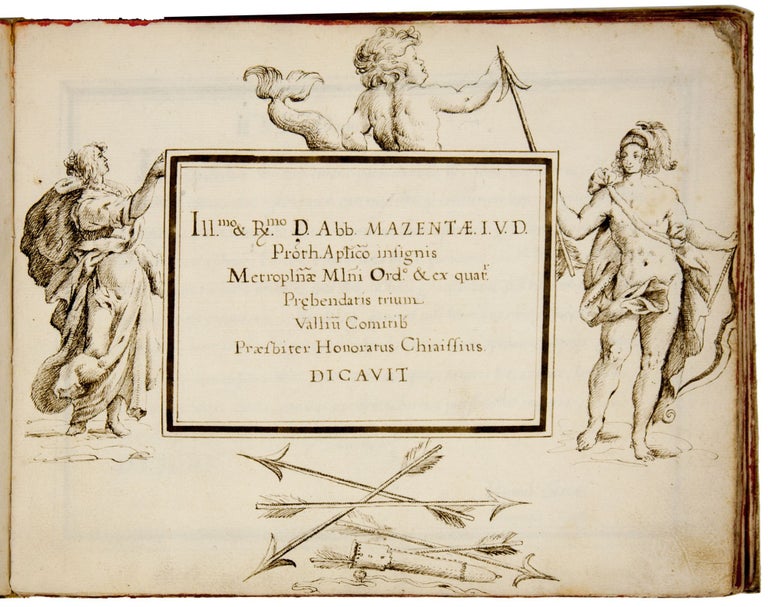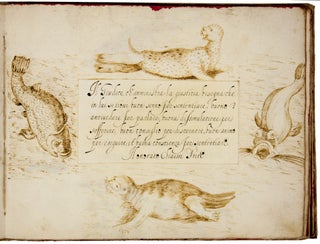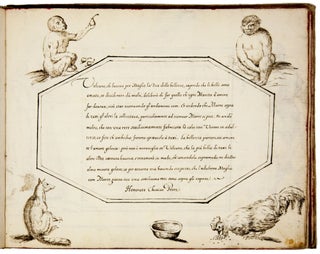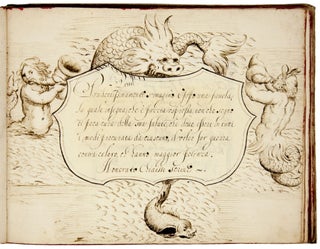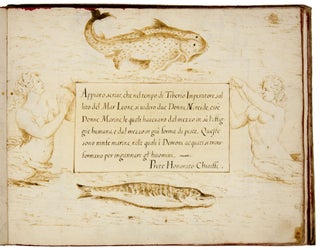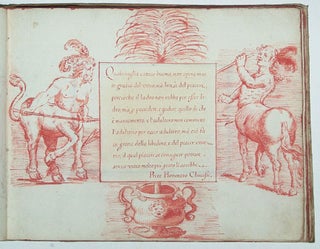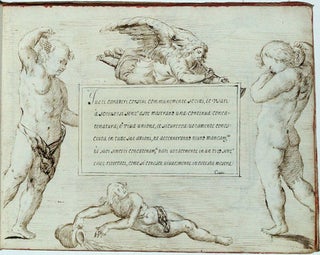Manuscript Writing Book with Ornamental Borders.
Oblong 4to [30 x 21.5 cm]. Some illustrations trimmed at the time of the binding of the album. (56) ff. of which 40 written and signed by Chiassi, including three alphabets, all except one written and ornamented on recto only, 27 pages with finely executed drawings, generally 4 subjects per page surrounding calligraphic sample, (5) blank ff., (10) ff. in a later hand and without ornamentation. Leaves trimmed to the binding with some loss of illustrations. Bound in contemporary flexible vellum, covers gilt-stamped with ornamental borders and title ‘Scritto da P. Honorato Chiaissi,” front cover soiled and worn, with holes; fingersoiling in lower right corners, some soiling on scattered leaves, minimal toning. An internally excellent copy in a splendid contemporary binding. Nothing further is known about the author, who identifies himself as “prete,” priest, in his signature. The notebook is a curious mixture of private and public, since it bears a dedication to one Abb. Mazentae (dated 16 August 1645), yet has an unfinished feel to it, with pages left blank. The texts reveal an obsession with the inconstancy of women, whose natural propensity towards infidelity needs to be curbed by vigilant fathers and husbands. Other recurring targets include courtiers and the rich who are easily corrupted by power and money.
Elaborate manuscript notebook by a mid-seventeenth-century priest from Milan containing his own aphorisms, observations and quotations modeled after contemporary calligraphy manuals with unusually elaborate and well-executed figurative borders drawn in his hand, and interspersed with anguished outbursts on love’s torment in a later hand. Chiassi’s drawings, modelled from Antonio Tempesta’s Hunting Scenes and contemporary emblem books, show mythological figures, exotic animals and putti, often matched to the content of the text: While we find no evidence that Chiassi was a professional artist, the numerous drawings show an unusually competent hand for an amateur. A peacock and a monkey adorn the calligraphed text on vanity and conceit; the drawing of a blond woman with a provocative décolleté appears next to a warning on women’s artifice. Chiassi borrowed his border imagery with great creativity and wit, sometimes hiding parts of the drawings behind the calligraphy to increase the overall sense of three-dimensionality. Concerned with this balance between image and text, he altered the position of a horse’s head from his printed source to keep it from disappearing behind the calligraphy framework. When he cites Tempesta’s Ostrich Hunt, only the protesting bird’s head and wings appear above the text; hunters rush at him from the sides of the frame with impossibly elongated, pronged sticks. A baying dog below from a different Tempesta Hunt completes the narrative circle. An unusual example of adapting the calligraphy book not for instructional purposes, but, apparently, for those of self-expression.
Ten leaves are covered in writing – without ornamental borders – in a later, and less skilled, hand, sometimes signed “P.G.” These include writing samples in French and German, while Chiassi’s entries are predominantly in Italian, with a few Latin exceptions. What makes these later entries intriguing is their diary-like character. Although they maintain the writing book style of Chiassi’s earlier entries – and share his obsession with women (“The snake inspires terror; but much worse is a woman”) – there are also more personal entries. The verso of f. 29 contains a crude draft of a poem on a lover’s torment whose blood freezes and whose heart is submerged in a tempest of doubts and torments. Leaf 30 contains the outcry “an unhappy love is worse than death!” and the statement on leaf 36, “Here is the lover in delirium only for you” is repeated on the fly leaf of the volume.
Price: $0.00

